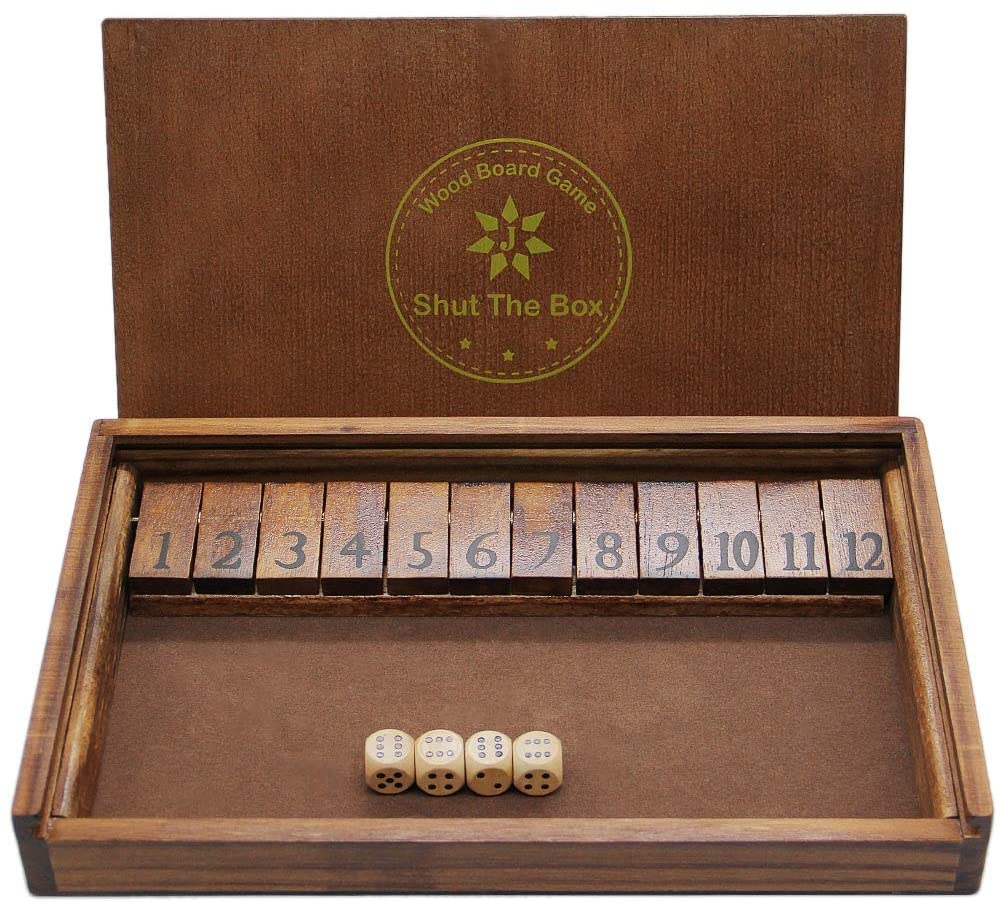TL;DR - choose either the option containing the largest number, or the fewest tiles and you’ll be ok!
Read on to learn more…
What am I talking about?
Over the summer at a friends house, I was presented with an “old bar game” that I was completely unfamiliar with. It’s a wooden tray, with the numbers 1-12 printed in ascending order on little wooden tiles.
Here’s an example of what it looks like:

The game we actually used was similar but had four sides, so that four players could play at the same time. The goal in this case was to roll two six sided dice, and put down number of wooden tiles that add to the sum of the die. The person with the lowest sum of remaining, unflipped tiles wins.
So for example, on your first turn, all of the tiles, 1-12, are up. Let’s say you roll a 10, you can flip your 1 and 9 tile, or 2 and 8, or your 5, 3, and 2 tile, etc. Then you will roll again, flip tiles with the same sum as the sum you’ve rolled on the dice, and repeat. You continue until you cannot flip down tiles equal to the sum you have rolled.
Monte Carlo Simulation of Shut the Box Game
Of course I got to thinking about what the optimum strategy actually is for this game, and workshopped a couple ideas against my friends. It seemed like I was doing pretty well with a strategy of always taking the option containing the highest number, but I wasn’t really sure that was the best strategy. I thought about it a lot on the drive home. Finally, I decided it would be fun to write a short python script to simulate playing shut the box using different strategies, in order to put my strategy to the test.
You can find a Gist with the Python 3 script for this here.
It’s a bit “rough” - but the idea is that it’s a script to “roll some dice” randomly and select the shut the box moves based on a predefined, general strategy. I was excited to test my hypothesized best strategy of “always taking the option with the largest number”. But of course, you can see that I also included a completely “random” strategy, the strategy of taking down the most tiles possible, and finally strategy of taking the fewest possible tiles. The script just plays a given number of games (100k, decided arbitrarily to be long enough to give consistent results between runs) according to each defined strategy and tracks the average score, so that the strategies can be compared.
Results
Running each of these strategies 100k times and averaging the results gives average scores of:
| Strategy | Average Score (100k runs) |
|---|---|
| Random | 49.7 |
| As many tiles as possible | 53.8 |
| As few tiles as possible | 35.5 |
| Option containing largest number | 35.4 |
Based on this simple implementation, you’re definitely best off adopting either the strategy of taking of “always taking the option containing the largest number” or the strategy of “taking the fewest tiles possible”. You definitely want to have a plan, we can see that randomly choosing the tiles to put down doesn’t do so well in the long run. Just don’t plan to take down as many tiles as possible - that won’t pan out for you! :)
Some Details and Additional Ideas
A couple notes about the implementation of these strategies - the two best strategies perform statistically the same with the number of trials I’ve run.
Another note, is that when there was ambiguity, after the first step in the strategy, I implemented a random choice. So for example, if two valid options allow 2 tiles to be dropped, and we’re playing by the “take as few tiles as possible” strategy, I choose between those randomly. I applied the same approach to the “option with the largest number strategy”, when two or more options had the same max number - the option played was chosen randomly. I think this is a pretty reasonable approach for a casual player - but perhaps a composite strategy would preform better?
So for example, we could use the max strategy to result conflicts in the “take as few as possible” strategy. Or we could use the the “take as few as possible” strategy to resolve some conflicts in the max strategy. I did try both of these approaches, and I was a bit surprised to see that the did not reduce the score in significant way. Perhaps I’ll dig into this more in a follow up…
Wrapping Up
Anyway - of course it’s possible to calculate the real optimal strategy is for crushing your friends at Shut the Box using probability, and perhaps that would be a another good subject for a follow up post…
At least now if you ever come across this game, you’ll have a strategy to start with!